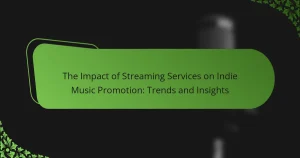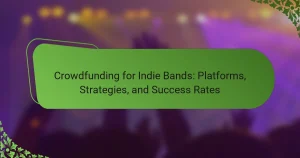Collaborating with other indie artists can significantly expand your reach and enhance creativity. This article explores effective collaboration strategies, common challenges, unique attributes that foster synergy, and metrics for measuring success. It also highlights best practices for maintaining long-term partnerships in the indie music community.
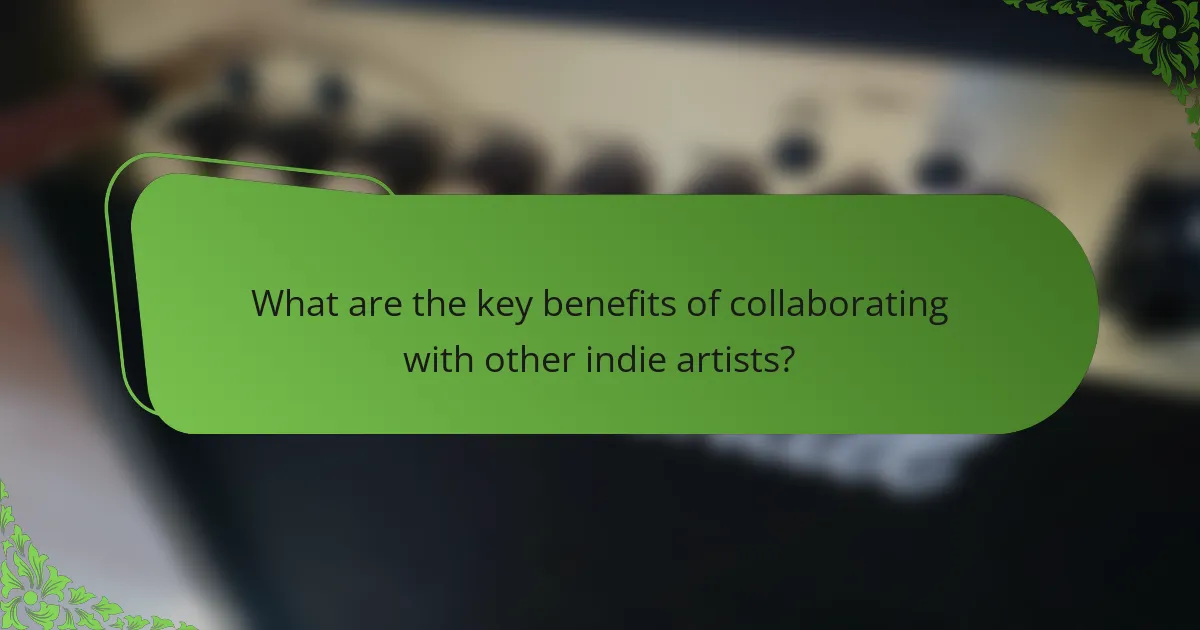
What are the key benefits of collaborating with other indie artists?
Collaborating with other indie artists offers numerous benefits, including expanded reach and shared resources. These partnerships foster creativity and innovation, leading to unique projects that attract diverse audiences. Collaborative efforts often result in increased visibility through cross-promotion, allowing artists to tap into each other’s fan bases. Additionally, sharing skills and expertise enhances individual growth and artistic development, creating a supportive community that thrives on collaboration.
How does collaboration enhance creativity and innovation?
Collaboration enhances creativity and innovation by combining diverse perspectives and skills. Working with other indie artists fosters a dynamic environment that encourages experimentation and new ideas. This teamwork leads to unique projects that may not emerge in isolation. Artists can share resources, knowledge, and networks, amplifying their creative potential. Additionally, collaborative efforts often result in a supportive community that motivates continuous improvement and exploration.
Which financial advantages can arise from partnerships?
Collaborating with other indie artists can lead to significant financial advantages. These partnerships can increase revenue through shared resources, expanded audience reach, and joint marketing efforts.
Pooling resources reduces costs for production and distribution. Artists can share studio space, equipment, and promotional expenses, leading to higher profit margins.
Collaborative projects often attract a larger fan base, resulting in increased ticket sales and merchandise revenue. Each artist brings their audience, amplifying exposure and potential earnings.
Joint marketing initiatives can enhance visibility without substantial individual investment. By leveraging each other’s platforms, artists can maximize promotional efforts and minimize costs.
What role does networking play in collaborative projects?
Networking is crucial in collaborative projects as it fosters connections that enhance creativity and resource sharing. By building relationships, indie artists can access diverse skills and perspectives, leading to innovative outcomes. Collaborative efforts often result in shared marketing efforts, increasing visibility for all involved. Additionally, networking can provide opportunities for mentorship and learning, further enriching the collaborative experience.
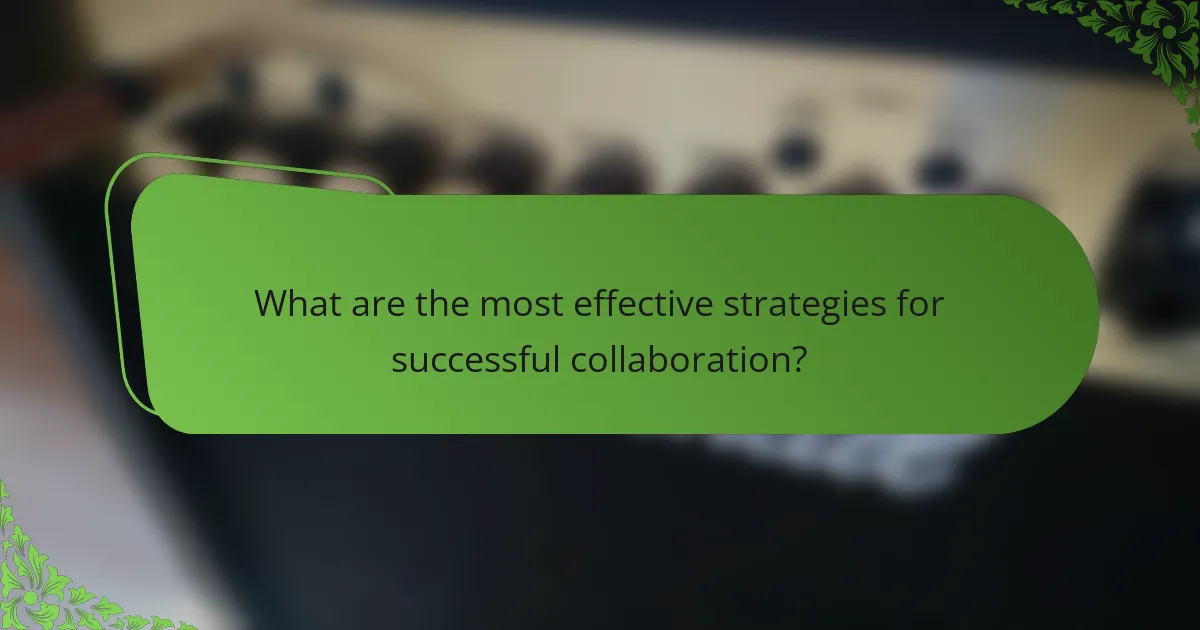
What are the most effective strategies for successful collaboration?
Effective collaboration strategies for indie artists include open communication, shared goals, and mutual respect. Establishing clear roles and responsibilities enhances productivity. Regular feedback loops foster creativity and innovation. Networking through events and social media expands opportunities. Leveraging each artist’s unique strengths creates a richer collaborative experience.
How can clear communication improve collaboration outcomes?
Clear communication enhances collaboration outcomes by fostering understanding, reducing misunderstandings, and building trust among indie artists. Effective dialogue enables artists to share ideas openly, align their visions, and coordinate efforts efficiently. This shared clarity leads to higher quality projects and stronger relationships, ultimately benefiting all parties involved. Clear communication also allows for constructive feedback, which can refine artistic processes and outcomes.
What tools and platforms facilitate collaboration among indie artists?
Collaboration among indie artists is facilitated by various tools and platforms that enhance communication and project management. Popular options include platforms like BandLab, which allows for real-time collaboration on music projects, and Soundtrap, offering cloud-based recording and editing.
Additionally, social media platforms such as Instagram and Facebook serve as networking tools, enabling artists to connect and share their work. Project management tools like Trello and Asana help organize tasks and deadlines, ensuring smooth collaboration.
These tools not only streamline the creative process but also foster community and support among indie artists.
Which roles should each artist assume in a collaborative project?
Each artist in a collaborative project should assume roles that leverage their unique strengths. For example, one artist may take on lead vocals while another handles instrumentation. This division enhances creativity and efficiency. Clear role definition fosters accountability and helps maintain focus on the project’s goals. Additionally, rotating roles can encourage skill development and keep the collaboration dynamic.
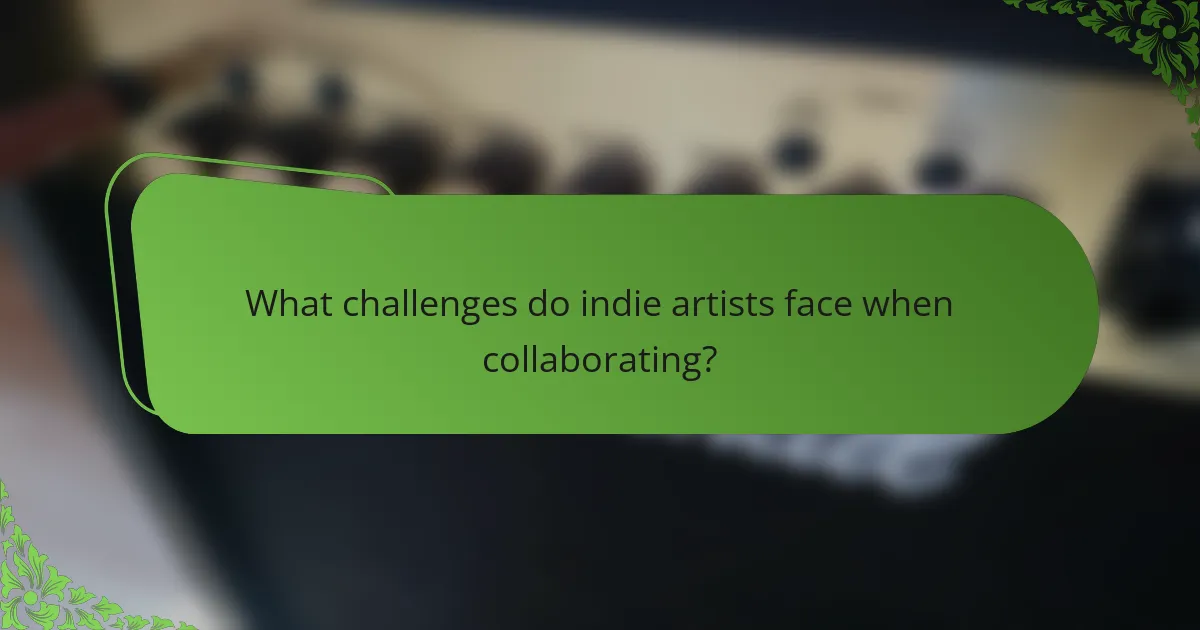
What challenges do indie artists face when collaborating?
Indie artists face several challenges when collaborating, including communication issues, differing artistic visions, and resource constraints. Effective collaboration requires clear dialogue to align goals and expectations. Artists must also navigate creative differences while maintaining their unique styles. Limited budgets can restrict access to professional resources, impacting project quality.
How can differing artistic visions create conflict?
Differing artistic visions can create conflict in collaborations. Misaligned creative goals may lead to misunderstandings and frustration. Each artist brings unique perspectives, which can clash during the decision-making process. Clear communication and mutual respect are essential to navigate these differences effectively. Establishing a shared vision at the outset can help minimize potential conflicts.
What are common logistical issues in collaboration?
Common logistical issues in collaboration include communication breakdowns, misaligned goals, scheduling conflicts, resource allocation challenges, and differing work styles. These issues can hinder progress and affect the quality of the final output. Effective planning and regular check-ins can mitigate these challenges.
How can financial disagreements impact collaborative efforts?
Financial disagreements can severely hinder collaborative efforts among indie artists. These conflicts often lead to mistrust, reduced communication, and a lack of shared vision. When artists do not align on financial expectations, it can create tension that overshadows creative processes. Consequently, unresolved financial issues may result in project delays or even cancellations, undermining the collaborative spirit. Establishing clear financial agreements and open communication can mitigate these risks and foster a more productive partnership.
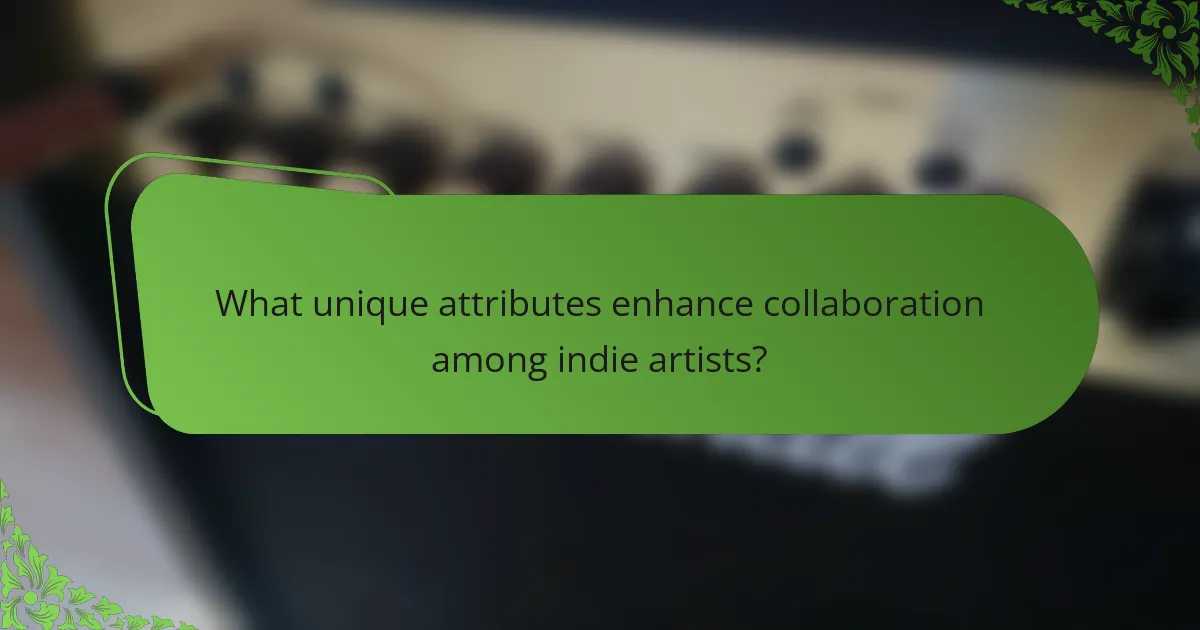
What unique attributes enhance collaboration among indie artists?
Unique attributes that enhance collaboration among indie artists include shared creative vision, diverse skill sets, and mutual support. A shared creative vision aligns artistic goals, fostering synergy. Diverse skill sets bring varied perspectives, enriching the collaborative process. Mutual support creates a positive environment, encouraging risk-taking and innovation. These attributes lead to stronger projects and deeper connections.
How does genre diversity influence collaborative projects?
Genre diversity enhances collaborative projects by fostering creativity and innovation. It allows indie artists to blend unique styles, resulting in fresh and engaging content. Collaborations across genres can attract broader audiences, increasing visibility and fan engagement. Diverse perspectives can lead to richer storytelling and musical experimentation, ultimately benefiting all artists involved.
What cultural influences shape collaborative dynamics?
Cultural influences such as shared values, artistic traditions, and community engagement shape collaborative dynamics among indie artists. These factors foster creativity and enhance communication, leading to innovative projects. Collaborative environments thrive on mutual respect and understanding, which are often rooted in cultural backgrounds. Additionally, regional music styles and local histories can inspire unique artistic expressions, making collaborations more enriching.
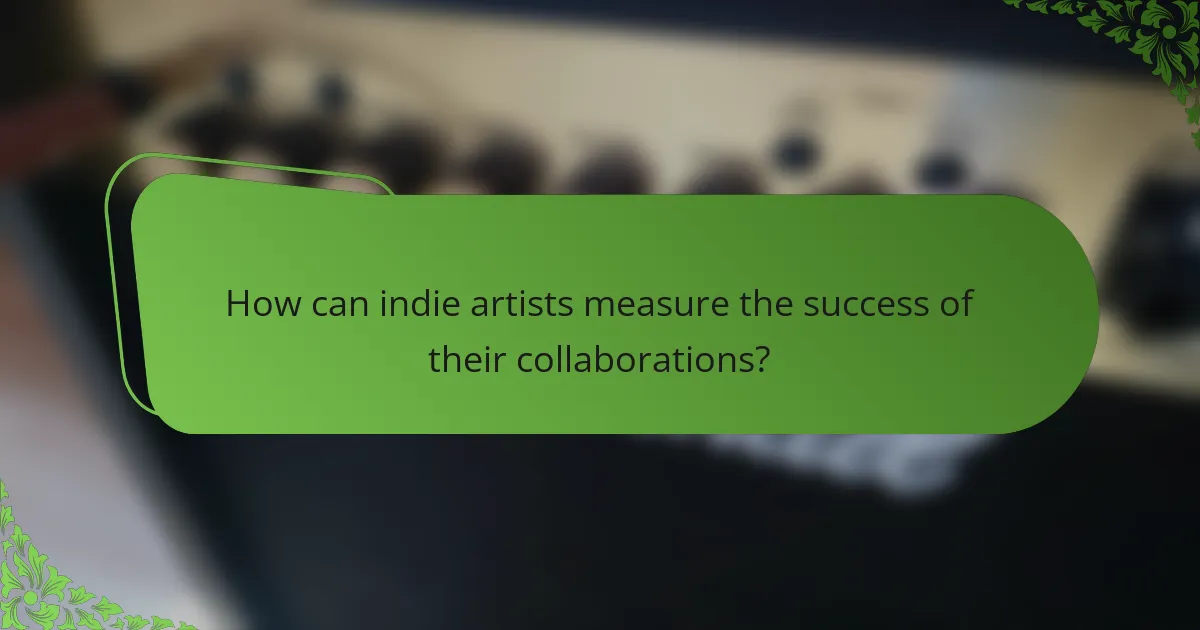
How can indie artists measure the success of their collaborations?
Indie artists can measure the success of their collaborations through various metrics. Key indicators include audience engagement, streaming numbers, social media growth, and feedback from peers. Tracking these metrics helps artists understand the impact and reach of their joint efforts. Additionally, setting specific goals before collaboration can clarify success criteria, such as increased followers or sales. Regularly reviewing these metrics allows for adjustments in future projects.
What metrics should be used to assess collaboration outcomes?
To assess collaboration outcomes, track metrics like project completion rates, audience engagement, and revenue growth. These indicators provide insight into the effectiveness of partnerships among indie artists.
| Metric | Description |
|—————————-|—————————————————|
| Project Completion Rate | Percentage of projects finished on time |
| Audience Engagement | Likes, shares, and comments on collaborative work |
| Revenue Growth | Increase in income attributed to collaboration |
| Creative Output | Number of new works produced collaboratively |
| Network Expansion | Growth in followers or fans across platforms |
| Feedback Quality | Positive reviews or testimonials from peers |
How can feedback loops improve future collaborations?
Feedback loops enhance future collaborations by fostering continuous improvement and open communication. They allow indie artists to share insights, identify strengths, and address weaknesses. This iterative process builds trust and refines collaborative strategies. As a result, artists can create more cohesive and impactful projects together.
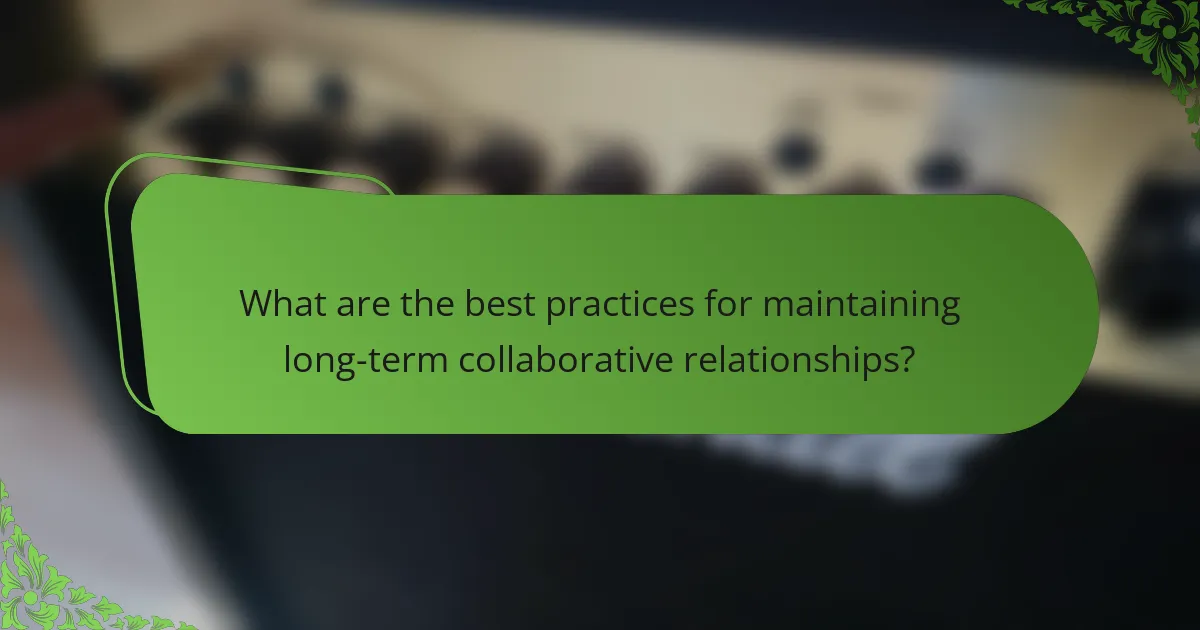
What are the best practices for maintaining long-term collaborative relationships?
To maintain long-term collaborative relationships with other indie artists, prioritize open communication and mutual respect. Establish clear goals and expectations from the outset to ensure alignment. Regularly check in with collaborators to foster trust and address any concerns promptly. Celebrate each other’s successes and provide constructive feedback, which strengthens the partnership. Lastly, be flexible and adaptable to changes, as this can enhance creativity and innovation in your collaborations.
How can regular check-ins strengthen partnerships?
Regular check-ins enhance partnerships by fostering communication and trust. They allow indie artists to align goals, share feedback, and address challenges promptly. This ongoing dialogue strengthens collaboration and encourages creative synergy. Regular interactions can lead to innovative projects and mutual support, ultimately benefiting both artists.
What strategies help resolve conflicts amicably?
Collaborating with other indie artists can resolve conflicts amicably through open communication, mutual respect, and compromise. Establishing clear expectations from the start helps prevent misunderstandings. Regular check-ins can foster a collaborative atmosphere, allowing for the discussion of concerns before they escalate. Using conflict resolution techniques, such as active listening and finding common ground, encourages a positive outcome. Documenting agreements and decisions ensures transparency and accountability, further strengthening the collaborative relationship.
Which common mistakes should be avoided in collaborations?
To avoid common mistakes in collaborations, prioritize clear communication, set mutual goals, and respect each artist’s creative process. Misunderstandings can arise from vague expectations, so establish defined roles early. Another mistake is neglecting to celebrate each other’s contributions, which can lead to resentment. Lastly, failing to provide constructive feedback can stifle creativity and growth.
What expert tips can enhance collaborative efforts among indie artists?
Collaborating with other indie artists enhances creativity and expands reach. Effective communication is essential; establish clear goals and expectations. Utilize social media platforms to promote collaborative projects, increasing visibility. Regular feedback sessions foster improvement and strengthen relationships. Networking at events can lead to new opportunities and partnerships.
